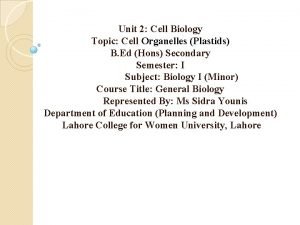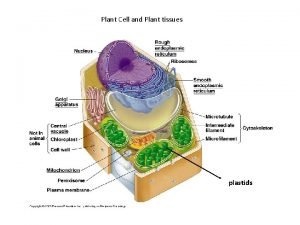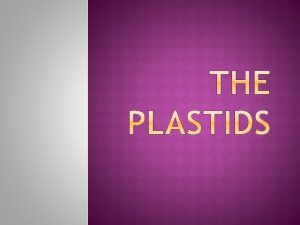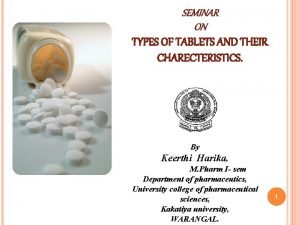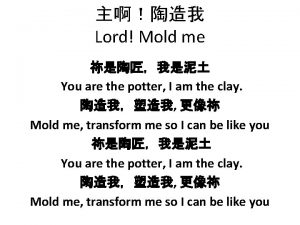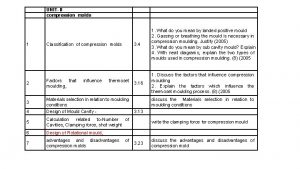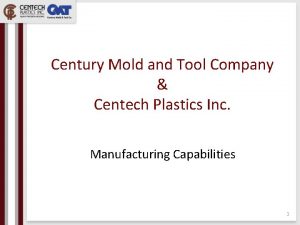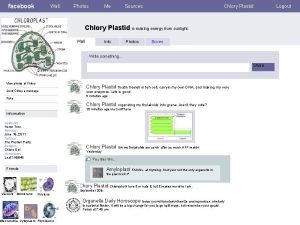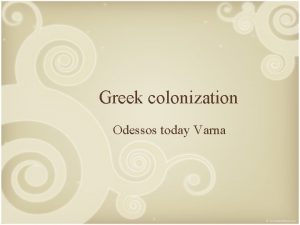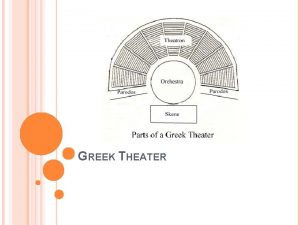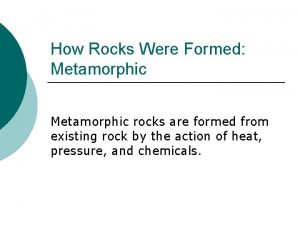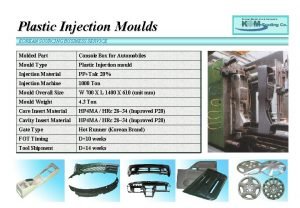INTRODUCTION The plastid Greek plasts formed molded is







































- Slides: 39




INTRODUCTION The plastid (Greek: plastós: formed, molded) is a major organelle found in the cells of plants and algae. � Plastids are the sites of manufacture and storage of starch, fatty acids, cuticle, epicuticular wax and terpenes which can be used for producing energy and important chemical compounds used by the cell. Therefore known as kitchen of plant cell. � Plastids often contain pigments used in photosynthesis, and others which determine the cell's color. � They possess a double-stranded DNA molecule, which is circular, like that of prokaryotes. � All plastids are derived from proplastids which are present in the meristematic regions of the plant. Proplastids and young chloroplasts commonly divide by binary fission, but more mature chloroplasts also have this capacity. �

STRUCTURE OF CHLOROPLAST

3 -D STRUCTURE OF CHLOROPLAST

In plants, plastids may differentiate into several forms, depending upon which function they play in the cell. Undifferentiated plastids (proplastids) may develop into any of the following variants: � Chloroplasts (green) plastids: for photosynthesis � Chromoplasts (coloured) plastids: for pigment synthesis and storage � Gerontoplasts: control the dismantling of the photosynthetic apparatus during senescence � Leucoplasts: colourless plastids: for monoterpene synthesis; leucoplasts sometimes differentiate into more specialized plastids: � � Amyloplasts: for starch storage and detecting gravity � Elaioplasts: for storing fat � Proteinoplasts: for storing and modifying protein � Tannosomes: for synthesizing and producing tannins and polyphenols � Depending on their morphology and function, plastids have the ability to differentiate, or redifferentiate, between these and other forms.

PLASTIDS CHROMOPLASTS AMYLOPLASTS CHLOROPLASTS

CHLOROPLASTS

INTER CONVERSION OF PLASTIDS

� Plastid DNA (plastome) is circular 75– 250 kilobase. The number of plastome per plastid is variable, ranging from more than 1000 to 100 or fewer in cells. Plastid multiply by divisions. � The plastome contains about 100 genes encoding ribosomal and transfer ribonucleic acid (r. RNAs and t. RNAs) as well as proteins involved in photosynthesis and transcription and translation of plastid’s genes. � The proteins synthesize by plastid DNA represent a small fraction of the total proteins necessary to build and maintain the structure and function of a particular type of plastid. Plant nuclear genes encode the vast majority of plastid proteins, and the expression of plastid genes and nuclear genes is tightly co-regulated to coordinate proper development of plastids in relation to cell differentiation.

Plastid DNA exists as large protein-DNA complexes associated with the inner envelope membrane and called 'plastid nucleoids'. Each nucleoid particle may contain more than 10 copies of the plastid DNA. � The proplastid contains a single nucleoid located in the centre of the plastid. The developing plastid has many nucleoids located at the periphery of the plastid. � During conversion of plastids from one type to another, nucleoids change in morphology, size and location within the organelle. The remodelling of nucleoids takes place by modifications in the composition and abundance of nucleoid proteins. � Many plastids, particularly those responsible for photosynthesis, possess numerous internal membrane layers. In plant cells, long thin protuberances called thylakoids form. �


Plastids in algae � In algae, the term leucoplast is used for all unpigmented plastids and their function differs from the leucoplasts of plants. Etioplasts, amyloplasts and chromoplasts are plant-specific and do not occur in algae. � Plastids in algae and hornworts may also differ from plant plastids in that they contain pyrenoids. � Glaucocystophytic algae contain muroplasts, which are similar to chloroplasts except that they have a cell wall that is similar to that of prokaryotes. Rhodophytic algae contain rhodoplasts, which are red chloroplasts that allow the algae to photosynthesize to a depth of up to 268 m.

PLASTIDS IN ALGAE

Inheritance of plastids Most plants inherit the plastids from only one parent. In general, angiosperms inherit plastids from the female gamete, whereas many gymnosperms inherit plastids from the male pollen. Algae also inherit plastids from only one parent. The plastid DNA of the other parent is, thus, completely lost. � In normal intraspecific crossings (hybrids formation), the inheritance of plastid DNA appears to be quite strictly 100% uniparental. � In interspecific hybridisations, the inheritance of plastids appears to be more erratic. Although plastids inherit mainly maternally in interspecific hybridisations, there are many reports of hybrids of flowering plants that contain plastids of the father. � Approximately 20% of angiosperms, including alfalfa (Medicago sativa), normally show biparental inheritance of plastids. �

Origin of plastids Plastids are thought to have originated from endosymbiotic cyanobacteria. The symbiosis evolved around 1500 million years ago and enabled eukaryotes to carry out oxygenic photosynthesis. � Three evolutionary lineages have since emerged in which the plastids are named differently: chloroplasts in green algae and plants, rhodoplasts in red algae and muroplasts in the glaucophytes. � The plastids differ by their pigmentation and ultrastructure. -The chloroplasts, have lost all phycobilisomes, the light harvesting complexes found in cyanobacteria, contains stromal and granal thylakoids -Red algae contains red pigment. -The glaucocystophycean plastid is still surrounded by the remains of the cyanobacterial cell wall. All these primary plastids are surrounded by double membranes. �

TEM IMAGES OF PLASTIDS

CHLOROPLASTS

TEM IMAGE OF CHLOROPLAST

Chloroplast: Structure and Function � Chloroplasts are present in plants and green algae. They are double membrane-bound plastids. They harbor light-harvesting pigments including chlorophyll, and serve as the site for photosynthesis (synthesis of food molecules) as well as some reactions of photorespiration. � Billions of years ago, a eukaryotic cell engulfed a cyanobacteria, which survived inside the cell, and later on evolved to become the chloroplast. � Chloroplasts contain a network of membranes called thylakoids which contains green pigment chlorophyll that imparts green color to plants and harvest light for photosynthesis. Thylakoids are embedded into a liquid matrix called stroma.


STRUCTURE � Chloroplasts are located in the parenchyma cells of plants as well as in autotrophic algae. They are oval-shaped organelles having a diameter of 2 - 10 µm and a thickness of 1 - 2 µm. Although their dimensions are almost similar in all plants, the algal chloroplasts show a variation in their size as well as shape. The major components of a chloroplast are as illustrated and explained below. � Envelope: The chloroplast envelope is doublemembrane structure comprising an outer and an inner membrane. Each of these membranes is a phospholipid bilayer, and is 6 - 8 nm thick. A 10 - 20 nm thick space present between the two membranes is known as intermembrane space.

CHLOROPLASTS IN PLANTS

� Stroma: The aqueous matrix present inside the double-membrane envelope is called the stroma. The internal components as well as several solutes are dispersed into the stroma. The stroma is especially rich in proteins, and contains several enzymes necessary for vital cellular processes. The chloroplast DNA is also present in the stroma along with ribosomes and other molecules required for protein synthesis. Starch synthesized through photosynthesis is stored in the stroma in the form of granules. � Thylakoids: In addition to the two membranes that form the envelope, chloroplasts contain a third internal membrane system called thylakoid membrane. Thylakoids are the internal, membrane-bound compartments. The internal portion of the thylakoid is called the thylakoid lumen, and contains plastocyanins and other molecules required for the transport of electrons.

� Grana: Some of the thylakoids are arranged in the form of discs stacked one above the other. These stacks are termed grana, and are connected to each other through intergrana thylakoids or stroma thylakoids. � Photosystems: Present in the thylakoid membranes, these are the structural and functional units for harnessing solar energy. A photosystem comprises a reaction center surrounded by light-harvesting or antenna complexes that contain chlorophyll, carotenoids, and other photosynthetic pigments, as well as the associated proteins. � Peripheral Reticulum: The chloroplasts of certain plants contain an additional set of membranous tubules called peripheral reticulum that originate from the inner membrane of the envelope. Tiny vesicles bud off from the inner membrane of the chloroplast, and assemble to form the tubules of peripheral reticulum.

Functions � Chloroplasts are the site for photosynthesis, which comprises a set of light-dependent and lightindependent reactions to harness solar energy and convert it into chemical energy. In addition to this the components of chloroplast participate in several regulatory functions of the cell as well as in photorespiration. � The envelope of the chloroplasts is semi-permeable, and it regulates the entry and exit of molecules from the chloroplast. The outer and inner membranes have specialized intermembrane proteins for the transport of large molecules in and out of the chloroplasts. In addition, they are the site for synthesis of certain lipid molecules as well pigments like carotenoids that are required for light harvesting.

� The light-dependent reactions of photosynthesis occur in the grana where photosynthetic pigments like chlorophyll a, chlorophyll b, carotenoids, etc. absorb light energy, which is then used to break down water molecules, and ultimately give rise to ATP, NADPH 2 and oxygen. � The stroma of chloroplasts is the site for the dark reactions of photosynthesis. The enzymes in the stroma utilize carbon dioxide from the atmosphere, as well as the ATP and NADPH 2 molecules released from grana, to synthesize sugar molecules and starch. This process is also known as carbon dioxide fixation, and occurs through a series of reactions collectively called Calvin cycle

�A part of the reactions that take place in the process of photorespiration (light-dependent oxygen fixation) occur in the stroma of the chloroplasts. Other reactions take place in the mitochondria and peroxisomes. Photorespiration has been speculated to play a protective role during drought stress and exposure to high amounts of radiation. � The function of peripheral reticulum of chloroplasts is not yet clearly understood. However, it has been suggested that these units are an adaptation for fast transport of metabolites and proteins from the intermembrane space into the chloroplasts.

INTERCONVERSION OF PLASTIDS

� � Leucoplasts (leukós „white“) are non-pigmented plastids. Lacking pigments, leucoplasts are colourless, so they are predictably located in roots and non-photosynthetic tissues of plants. They may become specialized for bulk storage of starch, lipid or protein and are then known as amyloplasts, elaioplasts, or proteinoplasts respectively. In many cell types leucoplasts have wide range of essential biosynthetic functions, including the synthesis of fatty acids, many amino acids, and tetrapyrrole compounds such as haem. In general, leucoplasts are much smaller than chloroplasts and have a variable morphology, often described as amoeboid. Extensive networks of stromules interconnecting leucoplasts have been observed in epidermal cells of roots, hypocotyls, and petals, and in callus and suspension culture cells of tobacco.

TEM IMAGE OF STARCH GRAINS IN CHLOROPLAST

� Etioplasts are pre-granal, immature chloroplasts but can also be chloroplasts that have been deprived of light, lack active pigment and can be considered leucoplasts. After several minutes exposure to light, etioplasts begin to transform into functioning chloroplasts and cease being leucoplasts. � Chromoplasts are found in fruits, flowers, roots, and stressed and aging leaves, and are responsible for their distinctive colors. This is always associated with a massive increase in the accumulation of carotenoid pigments. The conversion of chloroplasts to chromoplasts in ripening is a classic example. � Chromoplast are heterogeneous organelles responsible for pigment synthesis and storage in specific photosynthetic eukaryotes.

� � They are generally found in mature tissues and are derived from preexisting mature plastids. Fruits and flowers are the most common structures for the biosynthesis of carotenoids, although other reactions occur there as well including the synthesis of sugars, starches, lipids, aromatic compounds, vitamins and hormones. The DNA in chloroplasts and chromoplasts is identical. One subtle difference in DNA was found after a liquid chromatography analysis of tomato chromoplasts was conducted, revealing increased cytosine methylation. Chromoplasts synthesize and store pigments such as orange carotene, yellow xanthophylls, and various other red pigments. As such, their color varies depending on what pigment they contain. The main evolutionary purpose of chromoplasts is probably to attract pollinators or eaters of colored fruits, which help disperse seeds. However, they are also found in roots such as carrots and sweet potatoes. They allow the accumulation of large quantities of waterinsoluble compounds in otherwise watery parts of plants.

�When leaves change color in the fall, it is due to the loss of green chlorophyll, which unmasks preexisting carotenoids. In this case, relatively little new carotenoid is produced. �There are some species of flowering plants that contain little to no carotenoids. In such cases there are plastids present within the petals that closely resemble chromoplasts and are sometimes visually indistinguishable. Anthocyanins and flavo noids located in the cell vacuoles are responsible for other colors of pigment.

� Structure � and classification of chromoplasts Using a light microscope chromoplasts are classified into four main types. The � Having proteic stroma with granules � Composed of protein crystals and amorphous pigment granules � The third type is composed of protein and pigment crystal � The fourth type is a chromoplast which only contains crystals � Using an electron microscope chromoplasts are classified into five categories: Globular chromoplasts, Crystalline chromoplasts, Fibrillar chromoplasts, Tubular chromoplasts Membranous chromoplasts It has also been found that different types of chromoplasts can coexist in the same organ.

Evolution � � Plastids are descendants of cyanobacteria, photosynthetic prokaryotes, which integrated themselves into the eukaryotic ancestor of algæ and plants, forming an endosymbiotic relationship. The ancestors of plastids diversified into a variety of plastid types, including chromoplasts. Plastids also possess their own small genome and some have the ability to produce a percentage of their own proteins. The main evolutionary purpose of chromoplasts is to attract animals and insects to pollinate their flowers and disperse their seeds. Color can be a very important factor in determining which pollinators visit a flower, as specific colors attract specific pollinators. White flowers tend to attract beetles, bees are most often attracted to violet and blue flowers, and butterflies are often attracted to warmer colors like yellows and oranges. [5]

PLASTIDS EVOLUTION

 Plastid diagram
Plastid diagram Plastid in plant cell
Plastid in plant cell Plastid are present in
Plastid are present in Purchasing flashing injection moulding
Purchasing flashing injection moulding Drawout breaker
Drawout breaker Words with the stem plasto
Words with the stem plasto What are the supplies in addition to your basic manicuring
What are the supplies in addition to your basic manicuring Tablet definition pharmacy
Tablet definition pharmacy You molded me
You molded me Compression molded
Compression molded Types of defects in plastic moulding
Types of defects in plastic moulding Centech plastics inc
Centech plastics inc The greek miracle
The greek miracle Hát kết hợp bộ gõ cơ thể
Hát kết hợp bộ gõ cơ thể Ng-html
Ng-html Bổ thể
Bổ thể Tỉ lệ cơ thể trẻ em
Tỉ lệ cơ thể trẻ em Chó sói
Chó sói Tư thế worms-breton
Tư thế worms-breton Chúa sống lại
Chúa sống lại Các môn thể thao bắt đầu bằng tiếng đua
Các môn thể thao bắt đầu bằng tiếng đua Thế nào là hệ số cao nhất
Thế nào là hệ số cao nhất Các châu lục và đại dương trên thế giới
Các châu lục và đại dương trên thế giới Cong thức tính động năng
Cong thức tính động năng Trời xanh đây là của chúng ta thể thơ
Trời xanh đây là của chúng ta thể thơ Mật thư tọa độ 5x5
Mật thư tọa độ 5x5 Phép trừ bù
Phép trừ bù Phản ứng thế ankan
Phản ứng thế ankan Các châu lục và đại dương trên thế giới
Các châu lục và đại dương trên thế giới Thể thơ truyền thống
Thể thơ truyền thống Quá trình desamine hóa có thể tạo ra
Quá trình desamine hóa có thể tạo ra Một số thể thơ truyền thống
Một số thể thơ truyền thống Bàn tay mà dây bẩn
Bàn tay mà dây bẩn Vẽ hình chiếu vuông góc của vật thể sau
Vẽ hình chiếu vuông góc của vật thể sau Biện pháp chống mỏi cơ
Biện pháp chống mỏi cơ đặc điểm cơ thể của người tối cổ
đặc điểm cơ thể của người tối cổ Thế nào là giọng cùng tên? *
Thế nào là giọng cùng tên? * Vẽ hình chiếu đứng bằng cạnh của vật thể
Vẽ hình chiếu đứng bằng cạnh của vật thể Vẽ hình chiếu vuông góc của vật thể sau
Vẽ hình chiếu vuông góc của vật thể sau Thẻ vin
Thẻ vin
